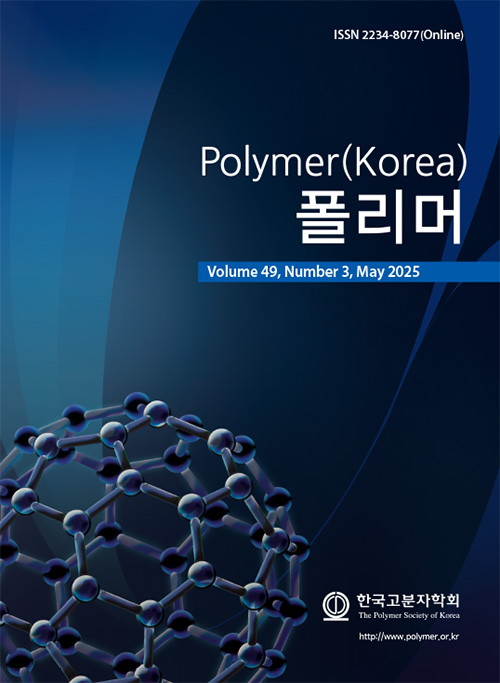- Improved Mechanical Properties : Composite of Surface-modified Cellulose Nanofiber and Ultra-High Molecular Weight Polypropylene
Jae-Ryong Lee#
 , Ju-Hong Lee#
, Ju-Hong Lee#  , Won-Bin Lim, Jin-Gyu Min, Sang-Wook Byun, Seoung-Ho Kim, Yi-Cheon Kim, Ji-Hong Bae†
, Won-Bin Lim, Jin-Gyu Min, Sang-Wook Byun, Seoung-Ho Kim, Yi-Cheon Kim, Ji-Hong Bae†  , and PilHo Huh†
, and PilHo Huh† 
Department of Polymer Science and Engineering, Pusan National University, Busan 609-735, Korea
- 향상된 기계적 특성:표면 개질 셀룰로오스 나노섬유와 초고분자량 폴리프로필렌의 복합체
부산대학교 응용화학공학부
Reproduction, stored in a retrieval system, or transmitted in any form of any part of this publication is permitted only by written permission from the Polymer Society of Korea.
Cellulose nanofiber (CNF) is a hydrophilic and biodegradable natural polymer with mechanical properties comparable to those of steel or Kevlar, whereas polypropylene is a hydrophobic polymer with excellent wear and heat resistance. The CNF surface was hydrophobically modified via grafting with vinyltriethoxysilane (VTES), and the modified CNF was compounded with ultra-high molecular weight polypropylene (UHMWPP) to produce a composite with improved properties compared to the neat polymer. The CNF surface modification was confirmed by Fourier transform infrared spectroscopy (FTIR) and X-ray photoelectron spectroscopy (XPS) analyses. To improve the dispersibility and uniformity of silane-modified cellulose nanofibers (Si-CNF) in UHMWPP, two drying methods spray drying and oven drying were compared. After spray drying, the Si-CNF powder was compounded with UHMWPP. Spray-dried Si-CNF was confirmed to have a particle size of 4~5 mm by field emission scanning electron microscopy (FE-SEM). The mechanical properties of the Si-CNF/UHMWPP composites improved with increasing Si-CNF content, as measured by a universal testing machine (UTM). The Si-CNF content was maintained below 5 phr to prevent yellowing of CNF and thermal deformation during the extrusion process.
셀룰로오스 나노섬유(CNF)는 강철이나 케블라와 유사한 물리적 특성을 가지는 친수성 및 생분해성 천연 고분자이며, 폴리프로필렌(polypropylene)은 내마모성과 내열성이 우수한 소수성 고분자이다. 비닐트리에톡시실란(VTES)과의 그래프팅(grafting)을 통해 소수성으로 개질된 CNF와 초고분자량 폴리프로필렌(UHMWPP)을 복합화하여 기존 대비 뛰어난 물성의 복합체를 만들고자 한다. CNF 표면 개질 과정은 푸리에 변환 적외선 분광법(FTIR)과 X선 광전자 분광법(XPS)을 통해 확인하였다. UHMWPP 내에서 실란 개질된 셀룰로오스(Si-CNF)의 분산성 및 균일성을 높이기 위한 방법으로 Si-CNF를 건조하는 과정에 있어 분무 건조와 오븐 건조 두 가지 방법으로 분말화를 수행하여 비교하였으며, 분무 건조를 통한 분말화 이후 UHMWPP와 복합화를 진행하였다. 분무 건조를 통한 분말화는 4~5 mm 입자 크기임을 전계 방출 주사 현미경(FE-SEM)을 통해 확인하였다. Si-CNF와 UHMWPP 복합화는 Si-CNF 함량이 증가함에 따라 물리적 특성도 증가하는 것을 만능 시험기(UTM)을 통해 확인하였다. CNF의 황변 현상과 압사출 공정에서 열 변형의 문제로 Si-CNF 함량은 5 phr를 넘지 않도록 하였다.
Keywords: polymer, polypropylene, ultra-high molecular weight polypropylene, vinyltriethoxysilane, modified cellulose, spay drying, compounding.
- Polymer(Korea) 폴리머
- Frequency : Bimonthly(odd)
ISSN 2234-8077(Online)
Abbr. Polym. Korea - 2024 Impact Factor : 0.6
- Indexed in SCIE
 This Article
This Article
-
2025; 49(3): 325-333
Published online May 25, 2025
- 10.7317/pk.2025.49.3.325
- Received on Nov 21, 2024
- Revised on Jan 21, 2025
- Accepted on Jan 21, 2025
 Correspondence to
Correspondence to
- i-Hong Bae , and PilHo Huh
-
Department of Polymer Science and Engineering, Pusan National University, Busan 609-735, Korea
- E-mail: jhbae@pusan.ac.kr, pilho.huh@pusan.ac.kr








 Copyright(c) The Polymer Society of Korea. All right reserved.
Copyright(c) The Polymer Society of Korea. All right reserved.